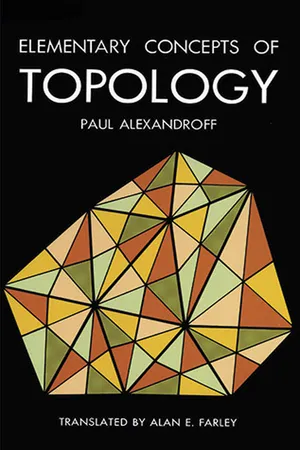
- 64 pages
- English
- ePUB (mobile friendly)
- Available on iOS & Android
Elementary Concepts of Topology
About this book
Alexandroff's beautiful and elegant introduction to topology was originally published in 1932 as an extension of certain aspects of Hilbert's Anschauliche Geometrie. The text has long been recognized as one of the finest presentations of the fundamental concepts, vital for mathematicians who haven't time for extensive study and for beginning investigators.
The book is not a substitute for a systematic text, but an unusually useful intuitive approach to the basic concepts. Its aim is to present these concepts in a clear, elementary fashion without sacrificing their profundity or exactness and to give some indication of how they are useful in increasingly more areas of mathematics. The author proceeds from the basics of set-theoretic topology, through those topological theorems and questions which are based upon the concept of the algebraic complex, to the concept of Betti groups which binds together central topological theories in a whole and upon which applications of topology largely rest.
Wholly consistent with current investigations, in which a larger and larger part of topology is governed by the concept of homology, the book deals primarily with the concepts of complex, cycle, and homology. It points the way toward a systematic and entirely geometrically oriented theory of the most general structures of space.
First English translation, prepared for Dover by Alan E. Farley. Preface by David Hilbert. Author's Foreword. Index. 25 figures.
Frequently asked questions
- Essential is ideal for learners and professionals who enjoy exploring a wide range of subjects. Access the Essential Library with 800,000+ trusted titles and best-sellers across business, personal growth, and the humanities. Includes unlimited reading time and Standard Read Aloud voice.
- Complete: Perfect for advanced learners and researchers needing full, unrestricted access. Unlock 1.4M+ books across hundreds of subjects, including academic and specialized titles. The Complete Plan also includes advanced features like Premium Read Aloud and Research Assistant.
Please note we cannot support devices running on iOS 13 and Android 7 or earlier. Learn more about using the app.
Information
III. Simplicial Mappings and Invariance Theorems.
Table of contents
- Title Page
- Copyright Page
- TRANSLATOR’S PREFACE
- PREFACE
- FOREWORD
- Table of Contents
- INTRODUCTION
- I. Polyhedra, Manifolds, Topological Spaces.
- II. Algebraic Complexes.
- III. Simplicial Mappings and Invariance Theorems.
- INDEX
- DOVER BOOKS ON MATHEMATICS